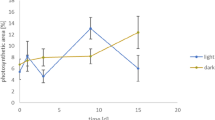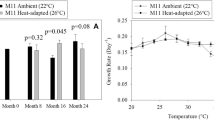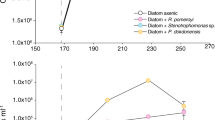Abstract
PHOSPHORUS and nitrogen have been suggested to be limiting agents in the unwanted growth of Cyanophyta. Removal of phosphorus from sewage effluents is being considered as the preferred method to control eutrophication. The significance of organic matter in lake water has been largely disregarded, although carbonaceous material is always found in productive lakes, for example, from 22 mg to 99 mg/l. of dissolved organic matter in the Great Lakes1. Massive growths of blue–green algae have been documented before the use of industrial phosphates, and they probably occurred always after a heavy influx of organic matter. Maximum growth of phytoplankton does not require high concentrations of phosphorus. As little as 0.02 mg of phosphorus/l. in natural lake water may sustain it2. Additional phosphorus alone does not increase growth because algal growth will depend on the presence and availability of not less than fifteen essential elements3.
This is a preview of subscription content, access via your institution
Access options
Subscribe to this journal
Receive 51 print issues and online access
$199.00 per year
only $3.90 per issue
Buy this article
- Purchase on Springer Link
- Instant access to full article PDF
Prices may be subject to local taxes which are calculated during checkout
Similar content being viewed by others
References
Robertson, A., and Powers, C. F., Tenth Conference on Great Lakes Research, Toronto (1967).
Rodhe, W., Symb. Bot. Upsaliens, 10, 1 (1948).
Coughlin, F. J., People, Pollution and Eutrophication, 35 (APHA Engineering and Sanitation Section, San Francisco, 1966).
Pearsall, W. H., J. Ecol., 20, 241 (1932).
Provasoli, L., Algae and Metropolitan Wastes, US Dept. Health, Education, and Welfare, 48 (1961).
Fitzgerald, G. P., Algae and Metropolitan Wastes, US Dept. Health, Education, and Welfare, 136 (1961).
Krauss, R. W., Algae and Metropolitan Wastes, US Dept. Health, Education, and Welfare, 40 (1961).
Schelske, C. L., Science, 136, 45 (1962).
Saunders, G. W., Bot. Rev., 23, 389 (1957).
Fogg, G. E., and Westlake, D. F., Verh. intern. Ver. Limnol., 12, 219 (1955).
Zehnder, A., and Gorham, P. R., Canad. J. Microbiol., 6, 648 (1960).
Staub, R., Schweiz. Z. Hydrobiologie, 23, 82 (1961).
Author information
Authors and Affiliations
Rights and permissions
About this article
Cite this article
LANGE, W. Effect of Carbohydrates on the Symbiotic Growth of Planktonic Blue–Green Algae with Bacteria. Nature 215, 1277–1278 (1967). https://doi.org/10.1038/2151277a0
Received:
Revised:
Issue Date:
DOI: https://doi.org/10.1038/2151277a0
This article is cited by
-
The facilitating role of phycospheric heterotrophic bacteria in cyanobacterial phosphonate availability and Microcystis bloom maintenance
Microbiome (2023)
-
Predicting Phytoplankton Growth and Dynamics in Relation to Physico-chemical Characteristics of Water Body
Water, Air, and Soil Pollution (2009)
-
The Effects of Cyanobacterial Exudates on Bacterial Growth and Biodegradation of Organic Contaminants
Microbial Ecology (2006)
-
Interactions of species in an Anabaena flos-aquae association from the Plußsee (East-Holstein, Federal Republic of Germany)
Oecologia (1983)
Comments
By submitting a comment you agree to abide by our Terms and Community Guidelines. If you find something abusive or that does not comply with our terms or guidelines please flag it as inappropriate.



